| Lesser Equar | Greater Equar | |
|---|---|---|
| Climate/Terrain: | Any | Any |
| Frequency: | Very rare (rare) | Very rare (rare) |
| Organization: | Solitary (herds) | Solitary (herds) |
| Activity Cycle: | Diurnal (good-aligned); Nocturnal (evil-aligned); Any (neutral-aligned) | Any (all alignments) |
| Diet: | See below | See below |
| Intelligence: | Very to High (11-13) | Exceptional (15-16) |
| Treasure: | Nil | Nil |
| Alignment: | See below | See below |
| No. Appearing: | 1 (3-8) | 1 |
| Armor Class: | 3 | 1 |
| Movement: | 18 | 24 |
| Hit Dice: | 6 | 9 |
| THAC0: | 15 | 12 |
| No. of Attacks: | 2 | 2 |
| Damage/Attack: | 2-12/2-12 | 3-12/3-12 |
| Special Attacks: | See below | See below |
| Special Defenses: | See below | See below |
| Magic Resistance: | Nil | 20% |
| Size: | L | L |
| Morale: | Champion (15-16) | Fearless (20) |
| XP Value: |
The equar is a horse-like species native to the Outer Planes. Nine different breeds of equar have been recorded, and from time to time they are summoned to the Prime Material Plane to act as steeds and helpers to powerful individuals. An equar’s appearance and demeanor vary from type to type. Each is strongly aligned to the same ethos as its native plane. An equar can speak the Common tongue, its alignment language, and by means of the spell that summons it forth, the same racial language as the caster.
The spell to summon these creatures creates a pact between a rider (who need not be the caster) and the equar. Each promises to look after the welfare of the other. The equar agrees to aid the rider, who in turn pledges to provide the unique food the equar craves while upon the plane.
A lesser and greater equar are actually the same creature; the term designates how fully the creature exists on the Prime Material Plane. A lesser equar still has some of its essence upon its home plane, while the greater equar has been wholly conjured. Thus, any equar encountered upon its home plane is a greater equar
Riding an equar has its dangers. Should the steed be dispelled through magic or circumstance, it immediately gallops to its home plane—with the unfortunate rider still in the saddle. Also, a rider who has proved to be the ideal of the alignment of the equar might unwittingly convince the creature that he deserves to be taken back to the equar’s home plane. A protection from evil/good spell or equivalent effect prevents the equar from carrying the rider off-plane.
Combat: Equars can act as warhorses. All can be fierce in battle, attacking with their front hooves. Creatures of opposing alignment are always attacked first.
Equars have keen senses and are never surprised. They are immune to petrification, disease, and poison. Equars cannot be affected by charm or beguile spells or their variants. They are harmed only by magical weapons of +1 or greater enchantment.
An equar can gallop back to its home plane at will, but it might well take any rider with it, as mentioned above.
Each equar has an innate weakness as detailed in each individual’s description. The special vulnerability may not be known by its summoner; after all, such beasts rarely mention their weaknesses to anyone, even a well-known and respected individual. Some arcane tomes that contain the spell to summon the beasts might offer a hint. The more obvious weaknesses though, such as those of the trothspyre and charnalbalk, soon become apparent to a rider.
The spell-like abilities possessed by lesser equars operate at 9th-level ability; greater equars make use of their talents at 12th-level ability.
Habitat/Society: Equars tend to travel the wide open areas on their native plane. They roam in small herds of no more than ten, lead by the strongest stallion. Lawful equars mate for life. A foal is born only once every 20 years and requires six months of parental care as it learns to gallop and use its special abilities. An equar has a life span of about 100 years.
More powerful denizens of the Planes often seek out an equar to use as a steed. Not always is the creature willing to accept the rider. Often, in the case of the Lower Planes, a fiend captures and subdues an equar. Bards of many Planes tell of incidents in which a summoned equar was thus accidentally released from such service and then pursued to the Prime Material Plane by the infernal denizen.
Ecology: On their native plane, equars graze on the natural plant life, though the evil equars also hunt for meat. Like the horses they resemble, an equar consumes a great deal to keep up its stamina. Only on the Prime Material Plane are the creatures eating habits extreme and they require such special diets as gold or poison to maintain their magical link to their home plane.
Trothspyre
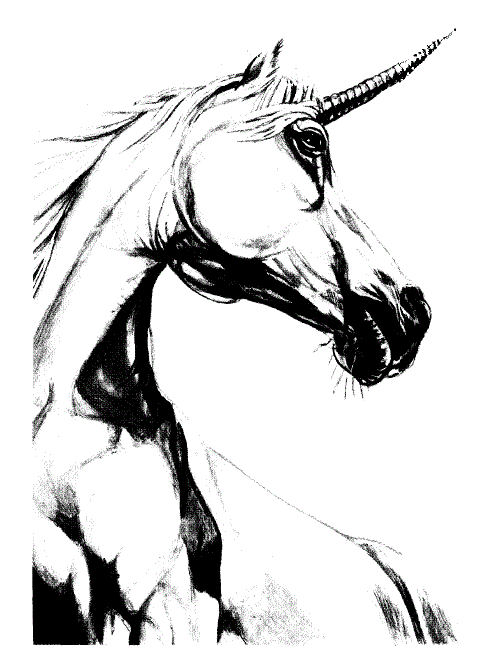
Lawful Good
The noble trothspyre is summoned from the verdant plains of Mount Celestia. Some sages have marked the resemblance between the trothspyre and the unicorn. Indeed, when seen from a distance, the two might be confused; but a trothspyre is markedly different from a unicorn, with crystalline hooves and a twisted horn rising from its brow. Some sages have commented that the horn is actually a symbol for the word “truth” in an archaic language. Evil creatures tend to avert their eyes, if possible, from the sight of the horn.
Diet: The trothspyre eats only the most fine and rare of grains, which must have been blessed by a lawful good priest; each such meal costs at least 50 gp. The creature will starve itself rather than eat mundane grains. The trothspyre must also spend at least four hours drinking in the sunlight every day to be sated. The trothspyre goes no more than two days without such a light-drinking before it views the pact with its rider null and void.
Special Abilities: Instead of trampling with its hooves, a trothspyre can impale an enemy upon its sharp horn, inflicting 1-10 hp damage (2-12 for a greater trothspyre). Any form of undead and any chaotic evil creature suffers double damage from the trothspyre’s horn attack.
A trothspyre can cast know alignment at will by touching an individual with its horn.
In addition to all common equar abilities, the trothspyre has the following spell-like powers:
Lesser: A trothspyre can cast detect lie and protection from evil twice per day and can seal wounds with a touch of its horn. This action heals only 1 hp of damage, but the wound stops bleeding, even if the victim has been affected by a sword of wounding or similar effect.
Greater: Trothyspyres can employ a detect lie spell on any creature within 20 feet unless the falsehood is hidden by an undetectable lie spell or similar effect. A touch of the creature’s horn seals wounds (as described above), and once per day the creature can cast cure serious wounds. A greater trothyspyre’s rider gains protection from evil while upon the equar’s back.
Special Weakness: A lesser trothspyre cannot exist on the Prime Material Plane after sundown. It slowly fades away, returning to its rider’s location (as long as the rider remains on the same plane) at daybreak. The greater trothspyre remains on the plane, to its chagrin, but its AC falls to 5, and the creature suffers a -1 penalty on all attack rolls until the next daybreak.
The Paladin's Throthspyre
Of the equars, only the lawful good trothspyre provides a suitable mount for the paladin. If the DM feels that the paladin has earned a special mount, he might allow a quest for a lesser or a greater trothspyre.
A paladin blessed with a lesser trothspyre warhorse receives a +1 bonus to Charisma while mounted atop the equar, and their combined aura is equivalent to a double-strength protection from evil spell. Attacks made by evil creatures against the paladin or his trothspyre suffer -4 penalties to attack rolls, and any saving throws caused by such attacks are made with +4 bonus.
In addition to the above powers, any paladin astride a greater trothspyre radiates a 30’ radius aura of bravery, affording himself and his nearby allies a +4 bonus to fear, hopelessness, antipathy, and phantasmal killer spells.
The pact between paladin and trothspyre is unbreakable for as long as the paladin remains a paragon of virtue. Should the paladin fall from grace, the trothspyre remains with its rider for as long as the paladin endeavors to redeem himself. If the paladin abandons his true calling, the trothspyre returns to its home plane in disgust.
A paladin who has remained honorable and faithful to his calling can coax his trothspyre steed into foregoing its usual diet in favor of a lesser meal if fine grains are unavailable, with the understanding that the equar will dine well when the opportunity presents itself. A trothspyre can live for months in this famished state but suffers a -1 penalty on attack rolls and saving throws (-2 for a greater equar) until fed well.
At any time, a paladin may heal his trothspyre’s hit points at the loss of his own. Similarly, a trothspyre may sacrifice any portion of its own hit points to heal its injured rider. The two must be in direct contact for this exchange to occur, and the one bestowing the hit points can never drop below 1 hp as a result of the transfer. Neither the trothspyre nor the paladin can heal others in this fashion; the exchange is limited to rider and mount
Gildmane

Neutral Good
A gildmane appears as a stout chestnut horse with a shimmering mane and hooves of pure gold that shine in the sun. equar lacks a tail. Legends claim that the first gildmane had a long flowing tail, but the creature angered a powerful fiend, causing havoc on the Prime Material Plane as it fled the demon’s wrath. The fiend chased the gildmane through the Astral Plane and across the spheres. In its fury, the fiend was heedless of the track the equar was taking. Thus the equar lead the fiend into the midst of Elysium, where it was slain by the denizens of that good Plane. Its final act was to grab hold of the gildmane’s long tail and tear it off. The equar rode on, and ever since then the gildmane has had no tail.
Diet: The gildmane’s peculiar diet demands worked gold (coins, jewelry, etc.), the purer the better. It consumes 200 gp value of the metal each day. Should it feast upon less for more than three days, the gildmane becomes surly and considers itself released from the pact, returning to Elysium.
Special Abilities: By touching a hoof to any suspect gold, the gildmane reveals the purity of the object: whether it is indeed gold or simply gold-painted iron or a lesser metal enchanted with the fool’s gold spell. A rider who knowingly supplies false gold to the equar voids the pact.
A gildmane can surround itself with a golden glow that provides light as per the light spell, and it offers a +1 on all saves for anyone within that 20’ radius against any form of curse or hex. Cursed magical items within this aura stand revealed for what they are and may be abandoned by their owners without fear of return, as if the proper spells (remove curse, dispel magic, etc.) or conditions necessary to lift the curse had been cast or met. This curse-breaking aura may be summoned but once per day and lasts for no more than one hour.
At any time, a gildmane can speak with an astral traveler by gently laying a hoof upon the creature’s body. Though the gildmane is said to have the gift to travel the Astral Plane, none has done so for centuries, perhaps fearing that the fiend that stole its tail still hunts it. Any attempt to take a gildmane into the Astral Plane is considered a breach of the pact.
In addition to all common equar abilities, the gildmane has the following spell-like powers:
Lesser: The gildmane can grant good fortune to an individual, lending a bonus of +1 (on 1d20) or +5% on an single roll once per day. The equar an cast glitterdust shield (protecting both itself and rider), and astral window, each once per day.
Greater: The gildmane can grant exceedingly good fortune to an individual, allowing either a +1 bonus for one turn to all rolls or a single +3 bonus to any single attempt, once per day. The equar can cast glitterdust, shield, and astral window all twice per day.
Special Weakness: Gildmanes attract the attention of evil creatures. Any and all monsters of Low intelligence (7) or lower must make a saving throw vs. spell every day while a gildmane is within one mile. Failure means that the evil creature is drawn to attack the equar and its rider when within range.
Favonian
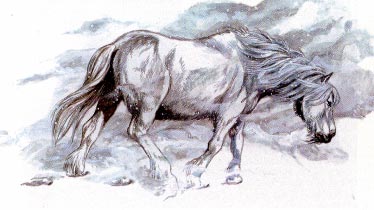
Chaotic Good
Known to travel the open fields of Arborea, favonians are unafraid of the worst weather conditions. These equars consider the downpours of major storms as nothing more troubling than a spring shower. They are pale horses, bluish-white or dappled gray.
Diet: A favonian’s diet upon the Prime Material Plane is one of rain water and ancient sagas. Of all the equars, the favonian most enjoys the songs and antics of bards and entertainers, seeking out such company when the opportunity arises. Rain water can be collected in barrels or found in puddles after a sudden downpour. Far more difficult to find are the epic poems and songs that the equar demands be read or sung in its presence; usually such passages must be found in old libraries or copied from the epitaphs of barrows. Failure to provide the favonian’s food and drink for three consecutive days convinces the equar that the pact is broken, and it departs.
Special Abilities: A rider never falls off a favonian unless the equar wishes it; even at the most grueling pace or windy conditions, a favonian’s rider is safe from being ousted from the saddle. Favonians also leave no tracks on any surface.
The senses of a favonian are not hampered by heavy rain, fog, or mist of mundane or magical origin. When in such weather conditions, the equar can conjure 1-3 phantom steeds, as per the appear spell. These phantasms identical to the favonian and may be ridden as normal horses. They also act as a mirror image spell, distracting enemies’ attacks from the real favonian.
In addition to all common equar abilities, they have the following spell-like powers:
Lesser: Favonians can cast alter normal winds (described in the Wizard's Spell Compendium [WSC]), gust of wind, and obscurement each once a day.
Greater: Favonians can cast alter normal winds (WSC), cloudburst (WSC), gust of wind, and obscurement all thrice per day. The equar can perform a flying gallop thrice per day (MC B), lasting one turn, during which the equar moves at normal movement rate through the air, as per the fly spell.
Special Weakness: Because of their admiration (some say even love) for bards, these equars never attack an entertainer, even one of sinister disposition. In dealing with such persons, they’d rather disperse the crowd and deprive the rogue of his or her audience- and thus his or her livelihood. A favonian will come to an entertainer’s rescue, even when such action deviates from the desires of its rider. A favonian’s rider who attacks a bard or other entertainer learns that the favonian considers this action a breaking of the pact. The favonian sternly admonishes the offender before departing the plane.
Lithicthil
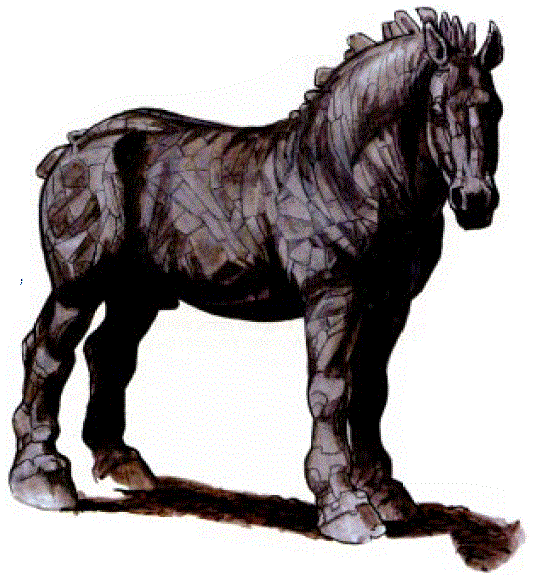
Lawful Neutral
The stalwart lithicthil rides through the open areas of Mechanus. At first glance, the lithicthil appears to be a living stone statue, but its flesh simply has an odd, sculpted look to it that resembles stone.
Diet: A lithicthil eats only worked materials—stone, wood, metal, clay, etc.—that have been enchanted in some way. Some are extremely finicky and eat only marble or wrought iron.
Special Abilities: Once per day, the lithicthil can increase any one attribute of its rider by 1-4 points (but not to exceed the racial maximum). The equar must be within 100 feet of the rider and often chooses itself which characteristic to augment; for example, a lithicthil who feels that its rider could treat it with more respect might choose to augment the rider’s Charisma, even if the rider would prefer an augmented Strength or Dexterity. The effect lasts five rounds for a lesser lithicthil, one turn for a greater. This equar can also detect enchantment at will, as per the detect magic spell, noting if an individual has been affected by any sort of spell from the School of Enchantment.
In addition to all common equar abilities, the lithicthil has the following spell-like powers:
Lesser: The equar can cast remove fear once per day
Greater: The lithicthil can cast remove fear thrice a day and meld into stone (rider and equar both affected) once per day. The rider is immune to fear while astride the lithicthil.
Special Weakness: Exposure to random magic is detrimental to this equar. It suffers a -2 penalty on all saving throws against wild magic (and the greater lithicthil’s magic resistance does not apply to such dweomers), and any magical item that has random effects or powers (such as a bag of beans or a wand of wonder) will not function normally within 100 feet of an lithicthil; instead, the item will permanently drain itself of all magic to induce a wild surge (see Tome of Magic, page 7) within 100 feet of the equar, quite possibly affecting the item’s wielder along with the lithicthil, who—in addition to suffering the effects of the surge—also suffers 1-20 hp damage instantly.
Menthric
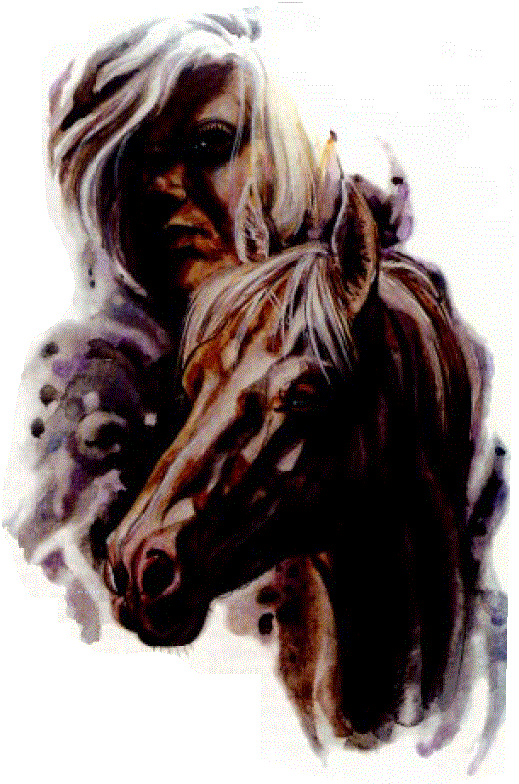
True Neutral
The menthric, native to The Outlands, appears as a normal horse and can have a variety of colors, from piebald to roan. But when seen out of the corner of the eye or with a true seeing spell or similar effect, the Menthric has the form of a plain-faced human dressed in non-descript clothing and shoulder-length hair. A perceptive person might notice that the menthric casts a human’s shadow rather than a horse’s This equar is often called upon when some event upsets the balance of power in the Prime Material Plane (for instance, during times of war, famine, and plague).
Diet: menthric must feed on enchanted script: magical scrolls, wizards’ spell books, and the like. Unfortunately, it is still vulnerable to any protective wards placed on the writing (such as explosive runes, sepia snake sigil, and the like), activated when the equar begins to eat. A menthric requires no less than four pages of magical script per day. If the equar must go for three days without this food, the pact is broken.
Special Abilities: A menthric has a talent for discerning weaknesses and strengths. If able to observe a creature for a full round, the equar can deduce whether the creature has any vulnerabilities or immunities. If the creature should have more than one special weakness or defense, the menthric can discover them with further scrutiny, learning one such trait per round. For instance, atop a hillcrest, a menthric and rider spy a horrid figure stumbling along the river bank. The menthric watches and notes that the creature favors its side, a sign of weakness. By waiting another round, the equar magically perceives that the wound was caused by fire and that flames are especially harmful to the monster. The forewarned rider readies a torch as they rush down to engage the troll.
A menthric can cast analyze balance and detect magic at will.
In addition to all common equar abilities, the menthric has the following spell-like powers:
Lesser: The menthric can cast hold portal, knock, mending, and shatter once per day.
Greater: The menthric can cast hold portal, knock, mending, and shatter twice per day. Once per day, the equar can summon a unique magical shield to protect both itself and rider. This effect takes the form of the opposing energy/ force that the attacker is using and thus only works against spells or magical effects. The menthric (and its rider) suffers only half damage from the attack, one-quarter if a saving throw is successful. Thus, if a red dragon breathed on a protected menthric employing its magical shield ability, most of the flames would be blocked by a suddenly appearing ring of ice and frost. The equar galloping through a blade barrier would be encircled by flying bucklers. This arcane shield lasts for one turn.
Special Weakness: A menthric is a creature of balance, prone neither to chaotic behavior (rash decisions) or lawful deliberation. It uses its own instinctive nature as a guide. However, spells that induce such state tend to wear at the creature’s ties to the Prime Material Plane. Thus any true chaotic or lawful magic—including Priest spells of the spheres Law and Chaos, and those wizard spells that either induce a disordered state (such as chaos, Otto’s irresistible dance, polymorph other or unluck) or rigid state (such as domination or hold monster) have a 5% chance per level of the spell of driving the equar back to its home plane. This risk occurs only if the menthric fails any magic resistance and saving throw rolls. Unfortunately, the rider of a banished menthric is also sent with the equar.
Potherrounce
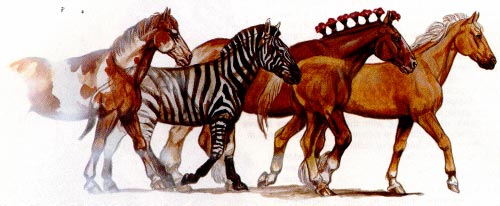
Chaotic Neutral
The potherrounce is a creature of true chaos, native to the wilds of Limbo. Though always a horse in basic form, it has no true appearance; every time one looks at a potherrounce, one sees something different. Thus, the first glance might show a zebra, while the next a draft horse with a mane of flower petals, and the next glance a dappled mare with three tails. This effect can be quite disconcerting, and superstitious folk intensely dislike and distrust this equar and any who associate with it.
Diet: Being borne from the forces of chaos, the potherrounce hungers for food similar in nature. Upon the Prime Material Plane, the only meals it eats are mixed magical potions (unmixed vials are unappealing to the equar; see Table 111 in the DUNGEON MASTER® Guide for the effects of mixing potions). Since the potherrounce demands fresh concoctions, the resulting mix can be quite volatile, and explosions have sometimes resulted in the demise of the rider. Still, the potherrounce laps up the strange brew. Failure to provide a drink of at least three different potions blended together once a week convinces the equar that the pact is broken.
Special Abilities: Because of its natural environs, the potherrounce’s magic resistance is effectively doubled against wild magic and surges. Also, a potherrounce’s senses are constantly patternweaving (see the Tome of Magic [TOM]). Thus the equar is unaffected by such spells as blur, chaos, confuse languages, confusion, fool’s speech, the reverse of tongues, and the like.
In addition to all common equar abilities, the potherrounce has the following spell-like powers:
Lesser: A potherrounce can cast blink, affecting both it and rider, three times per day. The rider is continually protected as by a chaos shield (TOM) while mounted on the equar.
Greater: The potherrounce can cast miscast magic (TOM) once per day. The rider gains more protection from wild magic, sharing the equar’s enhanced magic resistance against such dweomers. The potherrounce can urn ethereal with its rider for up to one hour each day. Because of the shifting appearance of the potherrounce, anyone with a full day’s exposure to the creature must make a saving throw vs. spell or lose 1 point of Wisdom. Should such an attribute fall to 0 through time spent in the equar’s presence, the individual goes permanently insane (until a restoration or limited wish spell is applied). Lost Wisdom is regained at the rate of 1 point per week spent away from the potherrounce.
Special Weakness: Any missile weapon blessed by a lawfully aligned priest inflicts double damage to a potherrounce. The equar attempts to retreat from such attacks if at all possible, even if its rider demands otherwise. Hold spells and other forms of paralysis inflict 1-3 hp damage per round on the potherrounce in addition to their usual effects, as the equar cannot freely shift its appearance under such effects.
Banecourser
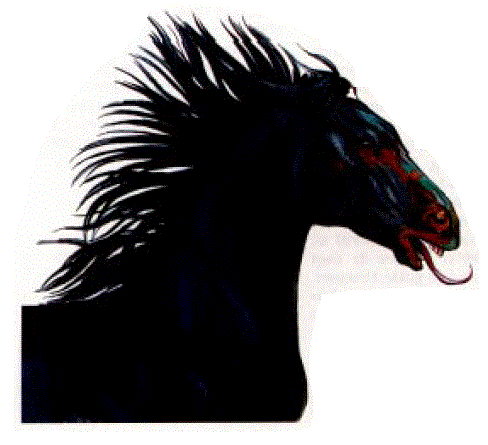
Lawful Evil
For villains, the banecourser is a grand mount. At first glance it appears to be nothing more than a fine black steed. Close inspection reveals its vile nature. Then one might see the odd streaks of rust and verdigris along its coat. When the equar opens its mouth, a serpentine tongue slips out for snake-like flicker. This equar dwells on the awful moors of Baator, but it is more than eager to appear on the Prime Material Plane and work with evil riders. Moonlight never illuminates a banecourser, and observation of this uncanny effect is one of the means to uncover the true nature of beast.
Diet: The banecourser must feed on deadly poisons. Many a rider has perished from accidental exposure to the venom gathered for the equar. The equar requires an average of 50 gp of such poisons per day, or else the pact is broken.
Special Abilities: The banecourser can detect poison by smell. With its flickering tongue, the creature can actually drain poison from any creature. This venom-theft can be performed upon a beast that has poison glands or sacs, thereby robbing it of such an attack. It can even remove the venom from a poison victim’s system, perhaps inadvertently saving a life in the process. To employ this special attack, the equar must first successful strike the target. Thereafter, it draws out the poison over the course of a number of rounds equal to the Hit Dice of a venomous creature or 2-7 rounds for a poisoned individual (who might well die before the poison is all removed). Each round the banecourser spends draining the poison, the target suffers 1 hp damage from the sharp tongue’s lapping.
Banecoursers have 60’ infravision but are irritated by daylight, suffering a -2 penalty on all rolls under such light, including the effects of a light spell or similarly bright illumination. This rider shares both the infravision and the sensitivity to light, unless wearing a helm, hat, or other apparatus to shield the eyes from direct light.
Interestingly, all creatures encountering the rider while he or she is in physical contact with the banecourser are affected as by a friends spell, with no saving throw allowed.
In addition to all common equar abilities, the banecourser has the following spell-like powers:
Lesser: The banecourser allows the rider’s words to act as a suggestion spell once per day.
Greater: The equar can cast suggestion and undetectable lie upon one of the rider’s statements once per day, with listeners suffering a -2 to saves to detect the lie. The rider is afforded protection from good while astride the banecourser.
Special Weakness: Banecoursers were cursed long ago by the goddess of the moon, as punishment for the equars’ taking part in the destruction of her high temple. Ever since, the banecourser has been unable to cross a line of silver (the metal sacred to the goddess). Though silver inflicts no harm to the equar, it irritates the equar; if the banecourser becomes trapped by a circle of silver, it departs the plane, the pact broken.
Due to the equar’s diet, a slow poison spell cast upon a banecourser acts as a slow spell, while a neutralize poison inflicts 4d6 hp damage. A periapt of proof against poison, if bound to a banecourser, forces the creature back to Baator for a period no less than one year.
Rosinante
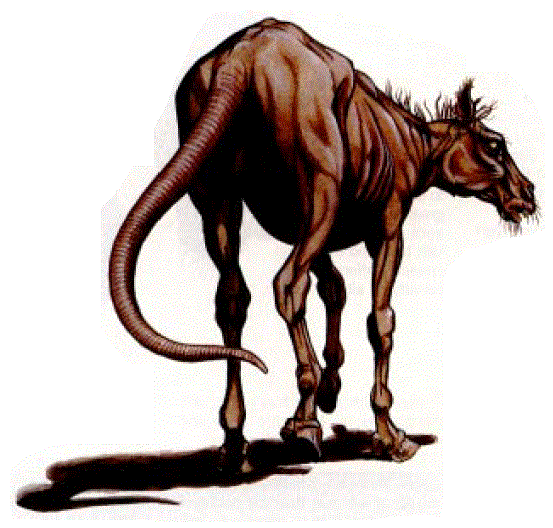
Neutral Evil
Though bards praise the melodious name of this equar, truly nothing about this creature hailing from The Gray Waste is the least bit lovely. A rosinante has the appearance of sickly, hairless horse with long rat’s tail. The eyes are unnaturally large and without pupils, looking like dead-white orbs. The rosinante’s teeth are crooked and small.
Diet: This equar dines only upon rotten meat and tainted water, and it insists on being hand-fed.
Special Abilities: Instead of its hooves, a rosinante can attack a foe with its prehensile tail. This attack can take the form of whipping that inflicts 1-4 hp damage (2-5 for a greater rosinante), or it can grasp a single-handed melee weapon. The lesser rosinante may wield weapons of S size, while a greater rosinante may employ M-sized weapons.
This equar can detect good at will through a magical sense of smell. The equar is also immune to the effects of a stinking cloud. They can see as well at night as they do at day.
In addition to all common equar abilities, the rosinante has the following spell-like powers:
Lesser: The rosinante can summon a swarm of verminous rats (as per the second-level Wizard spell summon swarm) up to twice a day. When necessary, the rosinante can Move Silently (60%) and Hide in Shadows (70%), even when ridden.
Greater: While riderless, this equar can shapeshift into a giant rat once per day and slip through small openings no less than one foot wide. The creature may also summon 1-3 giant rats once per day to aid its cause. Such creatures are under the complete control of the rosinante with no need for the equar to concentrate to keep the beasts in line. Note that the area where the rats are summoned must be hospitable to such rodents, or else none can be called. When necessary, the greater rosinante can Move Silently (80%) and Hide in Shadows (90%) as a thief, even while ridden.
Special Weakness: Restorative magic cast upon the rosinante actually harms the creature. Thus a cure light wounds inflicts 1-8 hp damage, a cure disease inflicts a disease, and so forth. A rosinante can be healed only by eating victuals affected by putrefy food and drink spell, regaining 1-8 hp per helping.
Charnalbalk

Chaotic Evil
Straight from the Abyss, the charnalbalk appears as an emaciated coal black horse with iron hooves. Its mane is tangled and unkempt. When a foal matures, the evil powers of the Abyss forge a terrifying iron mask and bolt it on the creature’s head; smoldering eyes glow from slits in the helm. The jaws of the beast stretch wide and are lined with sharp teeth and a pair of boar-like tusks.
Diet: The charnalbalk demands blood and warm flesh to dine upon, but such a meal must be from the same racial stock as the rider; sages suggest that this equar secretly harbors ill will toward any who dare ride it and thus chooses such as its diet, One victim slaughtered per day keeps the charnalbalk content. One such meal every three days keeps the pact of the spell, though the beast may at an inconvenient time attack a member of that race (other than the rider) to snack upon in the meantime.
Special Abilities: Instead of fighting with its hooves, a charnalbalk can bite an enemy with its daggerlike teeth, inflicting 2-8 hp damage (3-12 for a greater charnalbalk). If the beast scores a natural roll of “20,” it succeeds in tearing loose a hunk of flesh, thereby causing further 2-8 (3-12) hp damage; whether the wound is healed through natural or magical means, the strike always leaves a nasty scar.
Charnalbalks have 120’ infravision and can cause the spell-like effects fear and weakness (the reverse of strength) for one hour in any creature below 3rd level or 3 HD that meet its gaze. A successful saving throw negates this effect.
In addition to all common equar abilities, they have the following spelllike powers:
Lesser: The equar can cast invisibility to undead (affecting both itself and its rider) and heat metal each once per day.
Greater: The equar can cast invisibility to undead (affecting both itself and its rider) and heat metal each thrice per day. It can also cast animate dead once per day, but only corpses killed by the charnalbalk can be animated.
Special Weakness: A lesser charnalbalk cannot exist on the Prime Material Plane after sunrise. It slowly fades away at dawn, returning to its rider’s location at dusk. The greater charnalbalk remains on the plane, to its great annoyance, but its AC falls to 5, and the creature suffers a -1 penalty on all d20 rolls.
New Magical Item
The Saddles of Ahl Mitac
The conjurer Ahl Mitac was known throughout the world not so much for his tremendous magical prowess but for his many beloved daughters. When suitors began to visit the conjurer’s estate, Ahl Mitac decided to create a wondrous dowry for each child—a gift that not only would be valued for its worth but also could bring back swiftly any daughter who found her husband unkind. After many days of toil with local craftsman and countless nights spent consulting Planar charts, Ahl Mitac cast a dweomer upon several of the most finely-wrought saddles. Legend marks their number at seven, but some bards sing that there are as many as 13 enchanted saddles. (Some sages point out that the number changes frequently, depending on the length of the song the bard wishes to sing.)
Whenever any woman sits atop a saddle of Ahl Mitac (even if the saddle does not rest on a mount), an equar of the same alignment is instantly summoned as her steed. A pact can then be arranged between the rider and the equar. If at the time of the summoning a normal horse had been wearing the saddle, the equar interplanarly changes places with the animal.
XP Value: 1,000 GP Value: 5,000
New Spells
Summon Lesser Equar
| (Conjuration/Summoning) |
| Level: 5 |
| Range: 50 yds. |
| Components: V, S, M |
| Casting Time: 5 |
| Duration: 1 day/level of caster |
| Area of Effect: Summons 1 equar |
| Saving Throw: None |
This caster of this spell summons an equar from one of the Outer Planes. Before the creature agrees to assist the caster and take a rider, a pact must first be struck. The wording is not as important as the understanding (though some tomes suggest otherwise). In return for caring and feeding the equar, the beast agrees to serve the caster in a single endeavor for a period not longer than the spell’s duration. A rider must also be designated, though this need not be the caster. There are conditions in which an equar will feel that the pact has been broken. If it is improperly fed, betrayed to an opposite alignment, or attacked by the rider or caster, it will swiftly return to its home plane. The next time the conjurer attempts to summon an equar, he may well have to make amends for the spell to work.
A conjurer can call upon only an equar of the same alignment. No evil mage can ever summon one of the good equars, for instance. However, an equar will accept a rider with an alignment close to its own, but the mount might prove demanding and critical of any action it deems offensive. For example, a trothspyre might consent to bear a neutral good or lawful neutral rider, but the steed will extol the ways of virtue and ensure that its rider commits no evil.
The material component is an offering of food to the taste of the summoned equar. Only those that have first mastered the incantations for mount and monster summoning I can learn this spell.
Summon Greater Equar
| (Conjuration/Summoning) |
| Level: 7 |
| Range: 50 yds. |
| Components: V, S, M |
| Casting Time: 7 |
| Duration: 1 day/level of caster |
| Area of Effect: Summons 1 equar |
| Saving Throw: None |
This spell is similar to summon lesser equar, and the conjurer must have knowledge of that spell before learning this one. This version creates a more powerful call to the equar. The beast is more firmly bound to the Prime Material and thus has the statistics of a greater equar. In all other ways, this spell resembles the above.
by Steve Berman
